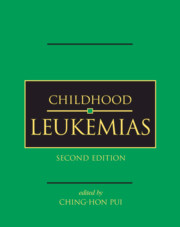Book contents
- Frontmatter
- Contents
- List of contributors
- Preface
- Part I History and general issues
- Part II Cell biology and pathobiology
- Part III Evaluation and treatment
- Part IV Complications and supportive care
- 29 Acute complications
- 30 Late complications after leukemia therapy
- 31 Therapy-related leukemias
- 32 Infectious disease complications in leukemia
- 33 Hematologic supportive care
- 34 Pain management
- 35 Psychosocial issues
- 36 Nursing care
- Index
- Plate Section between pages 400 and 401
- References
35 - Psychosocial issues
from Part IV - Complications and supportive care
Published online by Cambridge University Press: 01 July 2010
- Frontmatter
- Contents
- List of contributors
- Preface
- Part I History and general issues
- Part II Cell biology and pathobiology
- Part III Evaluation and treatment
- Part IV Complications and supportive care
- 29 Acute complications
- 30 Late complications after leukemia therapy
- 31 Therapy-related leukemias
- 32 Infectious disease complications in leukemia
- 33 Hematologic supportive care
- 34 Pain management
- 35 Psychosocial issues
- 36 Nursing care
- Index
- Plate Section between pages 400 and 401
- References
Summary
Introduction
Serious challenges to the psychosocial adjustment of the patient, parents, and patient's siblings are presented by the diagnosis of leukemia, its treatment and its clinical outcome. Many of these challenges, such as temporary shock and denial in the acute phase of diagnosis, are not specific to cancer and may be associated with other life-threatening conditions of childhood. Further challenges to adjustment, such as chronic learning problems associated with central nervous system (CNS) therapy, are more unique to childhood cancer and to leukemia in particular.
The purpose of this chapter is to highlight psychosocial adjustment challenges to patients and their families that are associated with acute and subacute reactions following diagnosis and with late adverse events following the completion of therapy. We focus special attention on issues that tend to be most prevalent in, if not unique to, childhood leukemia. Overviews of psychosocial research issues relevant to childhood cancer in general are available elsewhere, a recent review deals specifically with concerns in leukemia. For issues not addressed in this chapter, the reader is referred to several excellent recent publications, including a review of terminal care.
Issues during treatment
Nonpharmacologic approaches to pain and symptom management
Children with cancer are repeatedly subjected to a number of medical stressors in the course of their treatment, including painful procedures and chemotherapy-induced side effects. Standard methods, including patient support, patient education, and use of pharmacologic agents, have been employed with variable success in an attempt to decrease the distress associated with invasive procedures and treatment-induced symptoms.
- Type
- Chapter
- Information
- Childhood Leukemias , pp. 858 - 881Publisher: Cambridge University PressPrint publication year: 2006



